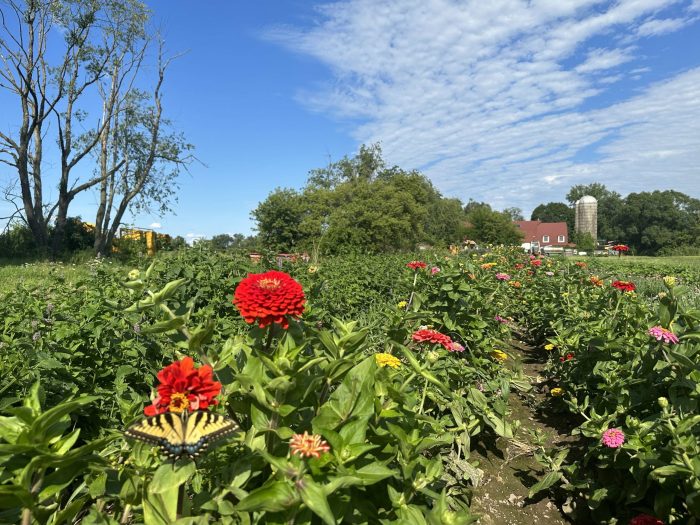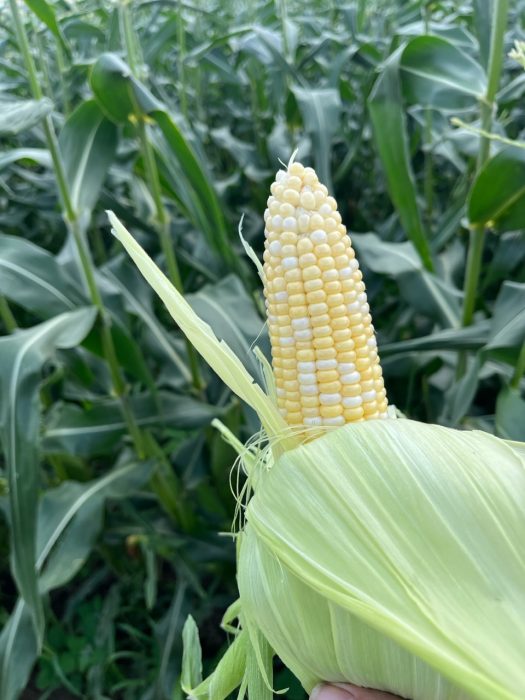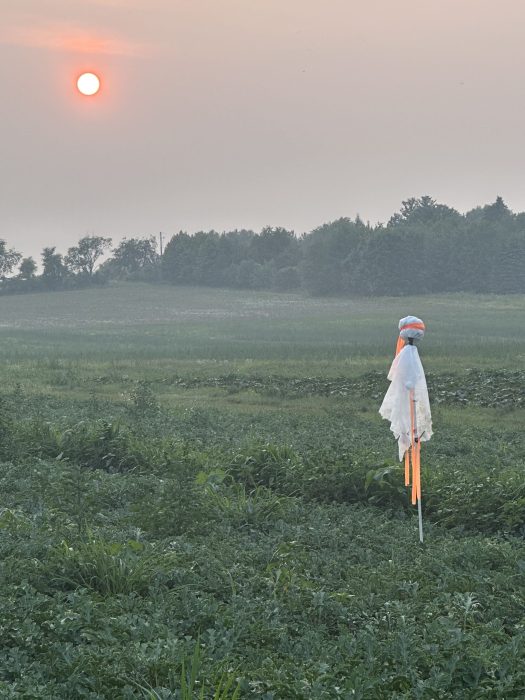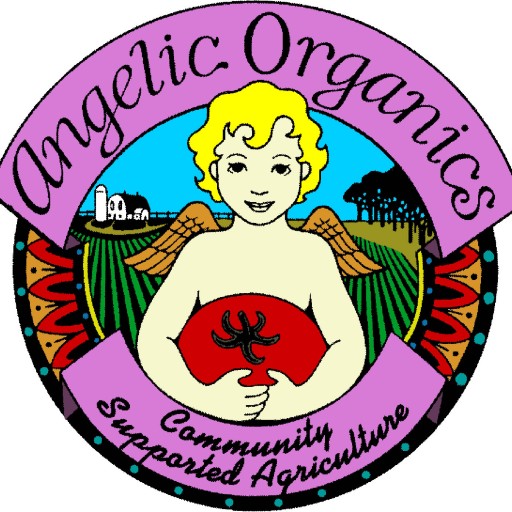Farmer John Writes: What Would Goethe Do?
Harvest Week 7, Deliveries of August 1st – 5th, 2023
Friends,
Another week of bounty at Angelic Organics, though we had to dance a bit with the storms.
Please, Before Emailing the Farm for Customer Service…
I mentioned this in last week’s issue of Farm News, but I want to make sure as many people as possible see it.
Growing the crops is a manageable challenge. Delivering them is a manageable challenge. Customer service is a challenge that is hard to manage.
My wife Haidy has been managing customer service until we find a suitable candidate to take on this role. Haidy is already fulfilling many other administrative tasks on the farm, so customer service is a stretch for her.
In addition, she is now away for a month’s stay in her home country of Finland, from where she will work remotely as needed. Please be judicious in contacting our office for customer service, as Haidy has other things to do in Finland than work full time for the farm.
Thanks to our FAQ’s, there are fewer emails that come in than in former years, but there we still receive a lot of emails—a lot. Consult our FAQ’s.You might find you don’t even need to push that Send button for customer service.
The U-Pick Garden is Open

Shareholders, come pick treasures in our U-Pick Garden. We have lots of string beans and flowers, also herbs—anise hyssop, sage, summer savory and thyme. Come any time between dusk and dawn, any day. No need to let us know when you are coming. The garden is just west of our barns, easy to get to by foot.
Before you come to the U-Pick Garden, please visit our U-Pick Garden web page for more details.
What’ll it Be Next Week?
Every Tuesday morning, Victor and I visit the fields to make a projection of what will be available for our shareholders the following week. This requires projecting the crops into the future. For instance, we have to fast forward the sweet corn, when we look at the ears on Tuesday, to the harvest before the pack on the following Monday. Those kernels that are smallish on Tuesday—will they be full and succulent in 6 days? What sort of heat are we expecting? What about rain? What about humidity?

2 1/2 days before the corn harvest; kernels still filling out—almost there
And the cucumbers—will they be ready in 6 days? What if we delay their harvest for another week? Will the tips shrivel? Will they get spongy, fibrous?
Arugula can go from small on Tuesday to the right size on Friday to flowering the following Tuesday. You might think this could not be the case, but it is. (No arugula to consider for this week.)
So, we not only have to project when the crop will be ready, but also project by when it will be beyond ready. (In addition, we have the challenge of forecasting the amounts available.)
The melons are starting to turn. I doubt they will be ready on Saturday. Will they ripen enough by Monday, a pack day? If we don’t harvest them by Monday, will the crows eat them? Will shareholders complain, because we didn’t put melons into their boxes, because they were not quite ready, and instead we added a substitute crop? (Most shareholders take substitutions in stride. Some don’t. Hey, it’s a farm, not Amazon.)

crows beware
We had to harvest the head lettuce two days earlier than we wanted. If it is a trifle smaller than you wish, know that we were unable to harvest it two days later, due to other harvest demands on that later day. Those two days might have increased the size of the heads by 15 to 25%—might have. Or it might have rotted with the heat and humidity.

lettuce harvest two days earlier than ideal
This projection of crops into the future is an unfolding, metamorphic development. It is not jumpy, like what screen editing strives for today, notably advertisements vying for your attention. It’s not rigid and formulaic, the way many conversations take place today. It’s not automatic and fixed, the way opinions are often held today. It is an evolving process. I can only achieve it by entering into it, merging with it, becoming it.
I like to credit Johann Wolfgang von Goethe a bit for my ability to look at our crops and mature or metamorphose them in my imagination.
I am not an authority on Goethe. I googled him and was bewildered at the number of far-ranging articles about him. In addition, Farm News is seldom a definitive treatise on any topic (except perhaps the art of how to get bumped by Taylor Swift). I will therefore just impart some indications about Goethe. It does warrant saying, though, that Rudolf Steiner, who in his 20’s was professionally immersed in documenting and critiquing Goethe’s work, was very inspired and informed by Goethe as Steiner developed his body of work known as Anthroposophy. Some of these inspirations and practices lie at the heart of Biodynamic farming, which Steiner founded and which we practice at Angelic Organics.
Readers of Farm News know that I seldom saturate my issues with quotes and long excerpts by other writers. I prefer to tell my own stories from my own point of view. However, in this case, I am basically relying on others for the main content of this issue.
What Would Goethe Do?
Johann Wolfgang von Goethe is mostly thought of as a poet, author and playwright, but he was also a frontrunner as a scientist. He advocated for a type of observation that did not distance the observer, but caused the observer to be part of the process of observation. Of course, contemporary scientific method does not embrace this partial departure from objectivity, but I must tell you that my projection of how your plants will grow in the next few days requires that I merge with the plants—not just think about them, but somehow become one with them, grow with them.
Goethe felt that studying plants should not be so much an observation as a conversation.
A conversation with plants? To ease the reader into this picture, I will first introduce the idea of conversation in a way that conversation is more commonly thought about—conversation between human beings. This brings me back to Goethe, Goethean conversation.
More Glorious than Gold
Let’s ponder this type of conversation through excerpts from an article by Marjorie Spock. Marjorie Spock, you might know, was very influential in providing the impetus to Rachel Carson’s Silent Spring, though allegedly she was never given much credit for her influence, since she was a follower and advocate of Rudolf Steiner’s work, which might have tainted Silent Spring as a sort of crackpot exposé, instead of a science-based exposé.
From The Art of Goethean Conversation by Marjorie Spock, 1983:
“Conversing, as Goethe conceived it, is the art of arts.
The very place in his works where the subject finds mention lets us glimpse its singular rank in his esteem. This is in a key scene of his fairy tale, The Green Snake and the Beautiful Lily. There, the four kings enthroned in the subterranean mystery temple are roused to the dawning of a new Age of Man when the serpent, made luminous by the gold she had swallowed, penetrates with her light into their dark sanctuary, and the following dialogue takes place:
“Whence came you hither?” asked the golden king.
“Out of the clefts where gold dwells,” replied the serpent.
“What is more glorious than gold?” “Light!”
“What is more quickening than Light?”
“Conversation!”
Unless one understands what Goethe meant one can feel disappointed at the serpent’s answer, which scarcely seems the revelation one expected. For is conversation as we know it in the Twentieth Century really more glorious than gold, more quickening than light? Hardly!
We attach the term to every casual exchange, to the most idle, inconsequential chit-chat. Surely, we feel, the term must have come down in the world since Goethe’s day, suffering severest diminution in its slide. That this is indeed the case becomes apparent when we recall the salons of earlier centuries where great minds came together for significant talk.
These occasions were of a wholly different order from our social happenings. They were disciplined, where ours are chaotic, built around a common purpose, mutually enriching rather than depleting.
It is impossible to picture the participants in a salon all talking at once, babbling away on as many subjects as there were pairs of conversationalists present. No!
The star of a theme hung over the assemblage as over a pool studded with crystals, and the responsively scintillating crystal intellects took turns voicing the reflections awakened in them.
Goethean conversations differ at least as much again from those of the salon as did the salon from today’s cocktail party. Their purpose is to call forth a fullness of spiritual life, not to stage displays of intellectual fireworks. They have nothing in common with the salon’s formal play of light-points sparkling in cold starlit glitter. Instead, they strive to enter the sun-warm realm of living thoughts where a thinker uses all himself as a tool of knowledge, where – in the manner of his thinking – he takes part as a creative spirit in the ongoing creative process…”
There is much more to ponder in Spock’s reflections on The Art of Goethean Conversation. I highly recommend that you read it all, but this issue of Farm News encourages you to at least consider the art of conversation with people as we enter into this idea or exercise of conversation with plants.
Do Plants Talk?
What might a Goethean conversation with a plant be like? Am I engaging in such when I project your crops into the future? Somewhat, I suppose…

Goethe in Italy by Johann Heinrich Wilhelm Tischbein
From The Nature Institute:
“In Goethe’s view science entails “mutual interaction” with the phenomena. Engaging in this process we discover the “limitless” nature of connections and relationships in the world but at the same time our potential to continually grow and adapt ourselves to new, more adequate ways of knowing. Doing Goethean science means treading a path of conscious development. The question accompanying every aspect of the work is, “How can I make myself into a better, more transparent instrument of knowing?” In traditional science, we are much more likely to ask, “How can I find ways of adapting the phenomena to my specific approach so that I can answer my question?”
Bringing it back to projecting the quantities and maturity of your vegetables and herbs several days into the future, I somehow, in part, become one with them. Somehow, they enter into me and unfold into their future with me and I see them arrive in a time that is not here yet.
Do they converse with me? Something like that.
From a Waldorf Library PDF by Dana Pauly:
“Goethean Science and Phenomenology
The most basic tenet of Goethe’s scientific method is that we enter into the experience of the phenomenon itself, remaining with it throughout our research, rather than speculating beyond it or replacing the phenomenon with an abstract concept or mathematical model. By dwelling in the phenomenon itself, Goethe maintained that one could come to “see” the unity and lawfulness of the natural world. In his scientific studies, he was seeking to explain nature by laws of development lying within nature itself, not external forces located outside nature.
Biodynamic Agriculture as a Practice of Goethean Phenomenology
The Biodynamic agricultural method, as an extension of Anthroposophy, Rudolf Steiner’s spiritual science, is Goethean in its vision and efforts to create a farm as a self-contained individuality. The farm is seen as a living and evolving individual organism within which the farmer lives and works. The subject/object (farmer/farm) distinction dissolves into a relationship in which the farm and its components (soil, plants, domestic animals, wildlife, water, etc.) are interdependent and necessary parts of a whole, rather than a mechanism for production, as is often the case in conventional and even organic farming. With this view, the relationship between the farmer and her farm is phenomenological. The unique wholeness of the farm is expressed in every part, and the farmer strives to experience and understand the system as a whole in order to work intimately and effectively with the landscape.”
Metamorphosis of this Newsletter
I started with an account of how I do harvest estimates for your share customization needs. This morphed into conversation with people. This morphed into conversation with plants. This morphed into how a farmer and his/her farm co-create one another, resulting in the Biodynamic farm organism.
It has to do with giving oneself over to the other—to the plants, to people, to the farm. It’s listening, paying attention. With the right approach, the people listen back, the plants listen back, the farm listens back. And the people reveal themselves, the plants reveal themselves, the farm reveals itself.
Rudolf Steiner noted, “It is a striking and pertinent fact that Goethe, when he looked out of a window, could often predict, hours in advance, what kind of weather was in store.”
“Hire that man!” I would have said.
Warmly,
Farmer John



